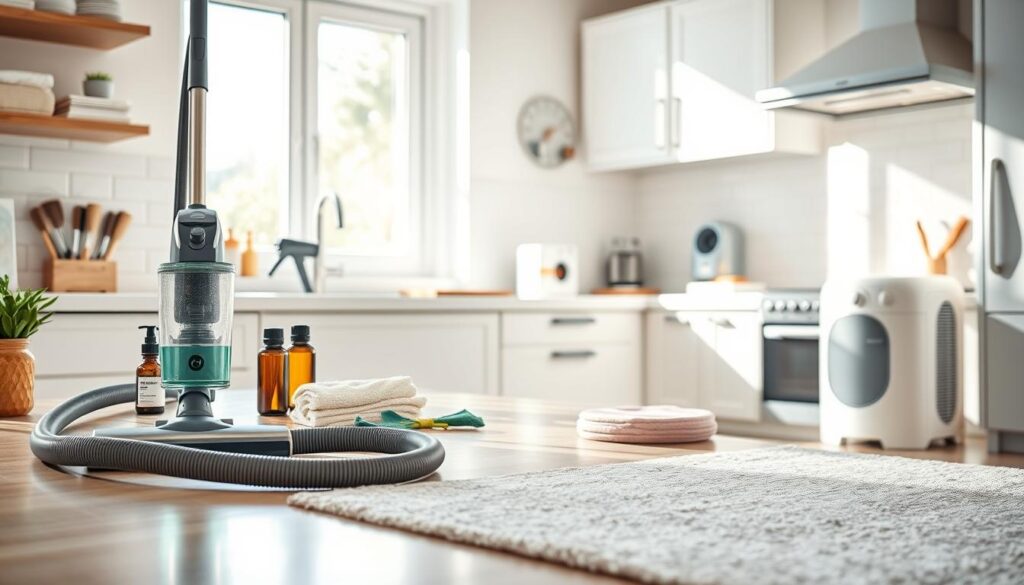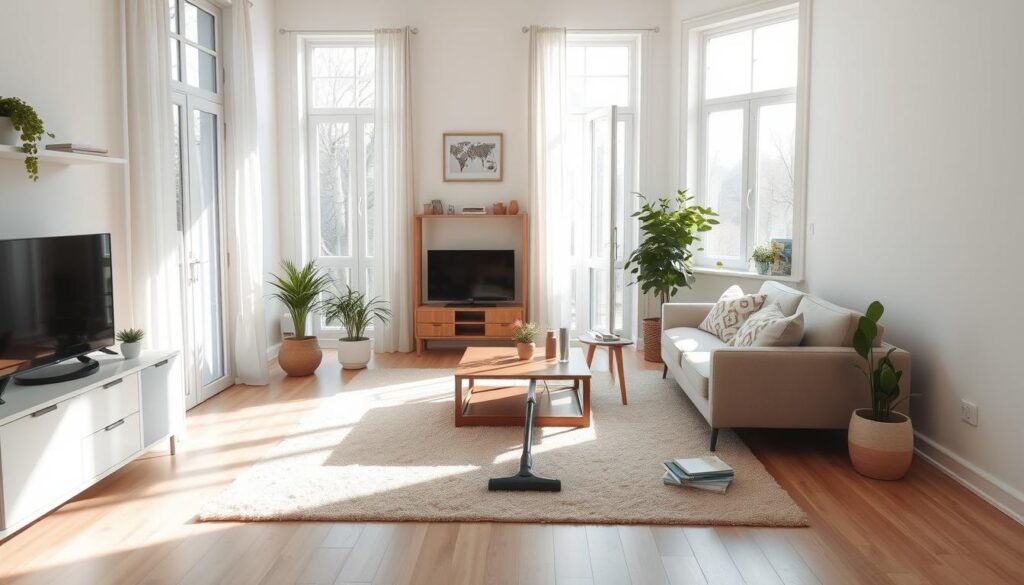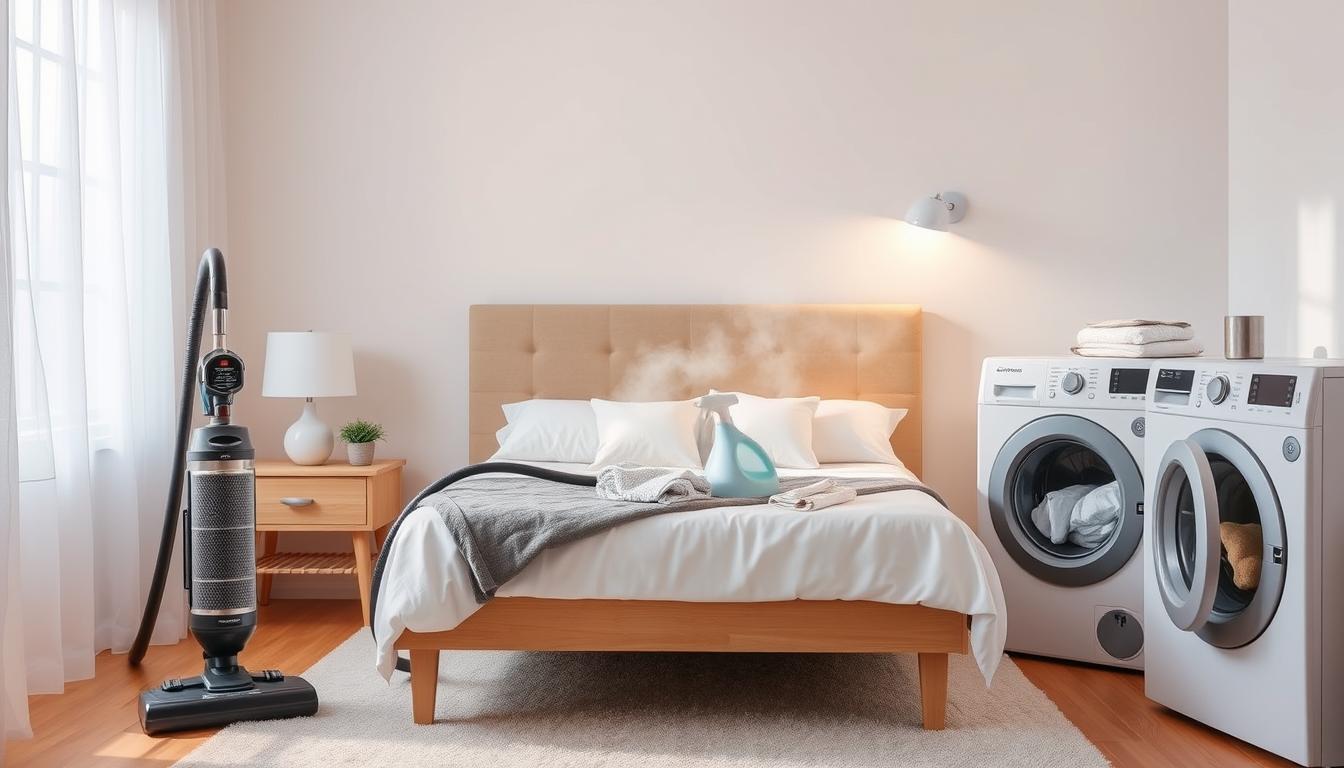Dust mites are tiny creatures that live in our homes, making it hard to keep our spaces clean and healthy. These pests love warm and humid places, growing fast in areas with dead skin cells. With millions in one home, getting rid of dust mites is key for good indoor health.
Dust mites are hard to see but can cause big health issues, especially for those with allergies or breathing problems. Knowing how to get rid of them is vital for a safer, more comfortable home.
Key Takeaways
- Dust mites thrive in humid environments above 50 percent
- Regular cleaning and controlling temperature are vital for prevention
- Hot water and high-heat drying can kill dust mites
- Air filtration systems help control dust mites
- Good home care can greatly lower dust mite numbers
Understanding Dust Mites and Their Impact on Health
Dust mites are tiny creatures that live in our homes, causing health problems for many. They love warm, humid places, making our homes ideal for them to grow fast.
What Are Dust Mites?
Dust mites are tiny spiders that eat dead skin cells. They live in places with fabric, like mattresses and carpets. An average mattress can have up to 10 million dust mites, making bedrooms their favorite spot.
Health Risks and Allergic Reactions
Dust mites can cause serious health issues, especially for people with breathing problems. About 20 million Americans are allergic to them. Their waste can make people’s immune systems react strongly.
- 10% of the population suffers from dust mite allergies
- 60-80% of asthma patients react to dust mite allergens
- Dust mite populations can double every 21 days in optimal conditions
Common Symptoms of Dust Mite Allergies
Dust mite allergy symptoms can vary from mild to severe. Common signs include:
- Persistent sneezing
- Itchy, watery eyes
- Nasal congestion
- Difficulty breathing
- Chest tightness
“Dust mites are silent invaders that can significantly impact indoor air quality and personal health,” says Dr. Emily Richardson, allergist at Stanford Medical Center.
It’s important to know about dust mites to keep our homes healthy. By understanding their effects and taking steps to prevent them, we can reduce our exposure and lessen allergic reactions.
Where Do Dust Mites Live in Your Home
Dust mites are tiny creatures that thrive in warm, humid places. They can be found in many spots in your home. Knowing where they live helps you fight them better.
Dust mites like places with dead skin cells and moisture. About 85% of US homes have dust mites. They are a big problem in many homes.
Primary Dust Mite Habitats
- Bedding and pillows
- Mattresses and box springs
- Carpets and area rugs
- Upholstered furniture
- Curtains and drapes
- Stuffed toys
- Furry blankets
The Environmental Protection Agency says dust mites don’t like dry air. They prefer temperatures between 60-80 degrees Fahrenheit and humidity over 50%.
| Location | Dust Mite Risk Level | Recommended Action |
|---|---|---|
| Bedroom Bedding | High | Wash weekly at 140°F |
| Carpets | Moderate to High | Vacuum twice weekly |
| Upholstered Furniture | Moderate | Steam clean quarterly |
“Knowing where dust mites live is the first step in controlling their population.” – Home Health Experts
Cleaning and controlling humidity can help fight dust mites. Keeping these areas clean will make your home healthier.
The Role of Temperature and Humidity in Dust Mite Control
To control dust mites, you need to understand how temperature and humidity affect them. Knowing this can help you make your home less welcoming to them.
Dust mites are very sensitive to their environment. Temperature for dust mites is key to their life cycle. They love warm places, between 68 and 77 degrees Fahrenheit, making your home perfect for them.
Optimal Temperature Settings
To fight dust mites, keep your home cooler. Here are some tips:
- Keep your home cooler, ideally below 68°F
- Use air conditioning during warm months
- Utilize fans to circulate cool air
Managing Indoor Humidity Levels
Controlling humidity is crucial in fighting dust mites. Keeping humidity below 50% can greatly reduce their numbers.
Using Dehumidifiers Effectively
“Controlling humidity is your first line of defense against dust mite infestations.” – Indoor Air Quality Expert
Get a good dehumidifier to keep your home dry. Use them in:
- Bedrooms
- Living areas
- Basements
By controlling temperature and humidity, you can make your home less friendly to dust mites. This helps reduce their numbers and allergic reactions.
Essential Bedding Protection Strategies
Keeping your bedding safe from dust mites is key to a healthy sleep space. Dust mite-proof bedding acts as a strong shield against these tiny allergen makers. They can really hurt your health and how well you sleep.
To keep dust mites away, you need to follow some important steps:
- Use allergen-proof covers for mattresses, pillows, and duvets
- Wash bedding weekly in hot water at 140°F (60°C)
- Utilize mattress protectors that block dust mite access
- Maintain bedroom humidity levels below 50%
“Your bed can be a sanctuary or a breeding ground for dust mites – the choice is yours.”
Choosing high-quality dust mite-proof bedding can greatly lower allergen exposure. Specialized protective covers make a solid wall that stops dust mites from taking over your bed.
Studies show that about 20% of people are allergic to dust mites. So, taking action to protect yourself is very important. By using these methods, you can make your sleep area cleaner and healthier. This might also help lessen allergy symptoms.
For things you can’t wash, running them through a tumble dryer on high heat for at least 15 minutes a week can kill dust mites.
How to Get Rid of Dust Mites in Your Mattress
Dust mites are tiny creatures that can make your mattress a source of allergies. About 20 million Americans have allergic reactions to dust mite waste. It’s important to know how to remove dust mites to keep your sleep area healthy.
Dust mites feed on dead skin cells. On average, a person sheds about 1.5 grams of skin daily. This makes mattresses a perfect place for them to live. But, there are ways to get rid of dust mites and keep your bed clean.
Steam Cleaning Methods
Steam cleaning is a great way to kill dust mites. The hot steam kills both the mites and their eggs. Here’s how to steam clean your mattress:
- Use a high-temperature steam cleaner (at least 130°F)
- Slowly move the steam cleaner across the entire mattress surface
- Pay extra attention to seams and crevices
- Allow the mattress to dry completely before remaking the bed
Protective Covers and Barriers
Using mattress encasements is another way to fight dust mites. A fully zippered mattress encasement can create an impenetrable barrier, keeping dust mites out.
Regular Maintenance Tips
To keep dust mites away, regular maintenance is essential. Here are some tips:
- Vacuum the mattress weekly using a HEPA filter vacuum
- Wash bedding in hot water (130°F) weekly
- Sprinkle baking soda and let it sit for 2-3 hours before vacuuming
- Expose mattresses to sunlight periodically to eliminate allergens
“Prevention is always better than cure when it comes to dust mite control.”
By using these dust mite removal techniques, you can reduce allergens and make your sleep area healthier. Remember, regular cleaning and protection are key to keeping dust mites away.
Effective Carpet and Flooring Solutions
Dust mites thrive in carpets. Studies show about 2,000 dust mites can live in just one ounce of carpet. This makes treating carpets for dust mites key to a healthy home.
Homeowners have many ways to control dust mites on floors:
- Hard surface floors like hardwood, tile, or laminate
- Low-pile carpets instead of plush ones
- Removable area rugs that can be cleaned often
If you want to keep carpets, there are ways to lower allergens:
- Regular vacuuming with HEPA filter vacuums
- Steam cleaning at temperatures above 140°F
- Using anti-allergen carpet treatments
- Keeping indoor humidity below 50%
Professional carpet cleaning can remove up to 90% of dust mite allergens more effectively than DIY methods.
Pro tip: Try diatomaceous earth as a natural dust mite control. Sprinkle it on carpets, wait a few hours, then vacuum well to kill dust mites.
By using these strategies, you can make your home cleaner and healthier. You’ll see a big drop in dust mite numbers.
Natural Methods to Eliminate Dust Mites
Fighting dust mites doesn’t need harsh chemicals. Natural methods are effective and safe for your home and health. Essential oils and non-toxic cleaning can greatly reduce dust mites.
Essential oils for dust mites are a strong and natural way to manage pests. They not only kill dust mites but also make your home smell fresher.
Essential Oil Treatments
Many essential oils are great against dust mites:
- Clove oil: It’s very good at killing dust mites.
- Eucalyptus oil: It keeps dust mites away.
- Tea tree oil: It fights bacteria and dust mites.
- Lavender oil: It smells nice and keeps dust mites away.
Natural Spray Recipe for Dust Mite Control
| Ingredient | Quantity | Purpose |
|---|---|---|
| White vinegar | 1 cup | Base solution |
| Eucalyptus oil | 15 drops | Dust mite killer |
| Clove oil | 10 drops | Acaricidal action |
| Lavender oil | 10 drops | Fragrance and repellent |
Non-Toxic Cleaning Solutions
There are more natural ways to fight dust mites:
- Spread diatomaceous earth on carpets.
- Steam clean mattresses and furniture.
- Wash bedding in hot water (60°C or higher).
- Freeze non-washable items for 24 hours.
Using these natural methods can make your home healthier without harsh chemicals.
Remember, being consistent is important in controlling dust mites. Regular cleaning and prevention keep your space dust mite-free.
HVAC Maintenance and Air Filtration Systems
Controlling dust mites in your home starts with a good HVAC system and strong air filtration. About 80% of US homes have dust mite allergens. So, managing air quality is key for good breathing.
To keep dust mites away, focus on a few important steps. The right air filter can cut down on allergens in the air. This makes your home air healthier.
“The quality of your indoor air directly impacts your health and comfort.” – Indoor Air Quality Expert
Here are some key points for dust mite air filtration:
- Choose HEPA filters that catch 99.97% of tiny particles
- Use MERV-rated filters of 11 or higher for better allergen capture
- Keep indoor humidity between 30-50% to stop dust mites from growing
| Filter Type | Dust Mite Capture Efficiency | Recommended Replacement |
|---|---|---|
| Standard Filter | Low (Below 50%) | Every 3 months |
| HEPA Filter | 99.97% | Every 6-12 months |
| MERV 13 Filter | 95% | Every 2-3 months |
Regular upkeep is essential. Professional HVAC services can boost your system’s performance. They help manage dust mites well.
By following these tips, homeowners can lessen dust mite numbers. This improves the air quality inside their homes.
Weekly Cleaning Routines for Dust Mite Prevention
Keeping your home clean is key to avoiding dust mites. These tiny pests can grow fast, doubling in just a week. A regular cleaning schedule can help keep them away and keep your family healthy.

To fight dust mites, you need a solid plan. This plan should cover all parts of your home. The goal is to cut down on dust and make your home less welcoming to dust mites.
Vacuuming Techniques for Dust Mite Control
Vacuuming is a crucial step in dust mite control. Here’s what experts suggest:
- Use a vacuum with a HEPA filter to catch 99.97% of dust
- Vacuum carpets, rugs, and furniture twice a week
- Focus on bedrooms and busy areas
- Use slow, overlapping strokes for deep cleaning
Washing Protocols for Dust Mite Reduction
Washing clothes and bedding right is vital. Follow these tips:
| Item | Washing Temperature | Frequency |
|---|---|---|
| Bedding | 130°F or higher | Weekly |
| Curtains | Hot water cycle | Monthly |
| Throw Pillows | 130°F | Bi-monthly |
Pro tip: Keep humidity below 50% to slow down dust mite growth and boost your cleaning efforts.
“Consistent cleaning is your best defense against dust mites” – Allergy Prevention Experts
By following these cleaning tips, you can make your home healthier. This will lower the chance of allergies. Remember, it’s easier to prevent than to treat.
Furniture and Upholstery Treatment Methods
Dust mites find upholstered furniture perfect for making allergens. To keep your sofas and chairs dust mite-free, you need a good cleaning plan.
- Vacuum upholstery weekly using a HEPA filter vacuum cleaner
- Use steam cleaning techniques to eliminate dust mites
- Wash removable covers in hot water (130°F or higher)
- Consider allergen-proof furniture covers
Steam cleaning is a top choice for getting rid of dust mites. Steam at 200°F kills dust mites and removes allergens.
| Furniture Type | Dust Mite Control Method | Cleaning Frequency |
|---|---|---|
| Fabric Sofas | Steam cleaning | Every 3-6 months |
| Leather Furniture | Regular wiping and vacuuming | Weekly |
| Removable Cushion Covers | Hot water washing | Monthly |
“Maintaining a dust mite-free environment requires consistent and targeted cleaning approaches.”
Pro tip: Pick furniture with smooth surfaces or covers that can be washed. Keeping humidity below 50% also helps keep dust mites away.
Choosing Dust Mite-Resistant Home Furnishings
Starting an allergen-proof home decor is all about picking the right furniture and materials. An average mattress can have over 2 million dust mites. So, choosing the right furniture is key to lowering allergen exposure.
Homeowners can greatly reduce dust mites by picking the right furniture.
When picking dust mite-resistant furniture, look for these materials:
- Leather: Smooth surfaces that don’t trap dust
- Vinyl: Easy to clean and less hospitable to mites
- Tightly woven fabrics: Reduce dust mite penetration
- Hard surfaces: Minimize dust accumulation
For an allergen-proof home, consider dust mite-resistant furniture solutions. These can greatly improve your indoor air quality.
| Furniture Type | Dust Mite Resistance | Cleaning Ease |
|---|---|---|
| Leather Sofa | High | Easy |
| Vinyl Chairs | High | Very Easy |
| Wooden Furniture | Medium | Moderate |
Pro tip: Regular cleaning and maintenance can help reduce dust mites. Vacuum upholstered items weekly. Use allergen-proof covers when you can.
Approximately 75% of people with asthma are sensitive to dust mites. This shows how important it is to choose furniture wisely.
Making smart choices in home furnishings can make your living space healthier. Focus on dust mite-resistant materials and keep up with cleaning. This way, you can lower allergen exposure and improve your indoor air quality.
Decluttering Strategies to Minimize Dust Mite Habitats

Decluttering for dust mites is more than tidying up. It’s a smart way to keep your home free from these tiny pests. By organizing, you can cut down on allergens and make your space less welcoming to dust mites.
“A clutter-free home is a healthier home” – Dust Mite Prevention Expert
Effective decluttering involves several key strategies:
- Remove unnecessary items that collect dust
- Create open spaces with minimal surfaces
- Use sealed storage containers
- Regularly clean and rotate decorative items
Pay special attention to high-risk areas like bedrooms and living rooms. Minimize fabric-based decorations such as throw pillows, extra blankets, and stuffed animals. These items are dust mite magnets, trapping moisture and providing perfect breeding grounds.
Storage solutions are key in preventing dust mites. Choose:
- Plastic containers with tight-fitting lids
- Vacuum-sealed bags for seasonal clothing
- Minimalist shelving units
- Regular rotation of stored items
Studies show that a clutter-free home can greatly reduce dust mite numbers. By using these organizing tips, you’ll make your living space cleaner and healthier. It will naturally resist dust mite infestations.
Conclusion
Controlling dust mites is key to a healthier home. Dust mite allergies affect 20 million adults and 6 million kids in the U.S. It’s important to reduce allergens to keep air clean and health risks low.
To manage dust mites, know where they live and use smart strategies. Keeping humidity low and using HEPA filters can help a lot. Washing bedding hot and vacuuming often also cuts down dust mites.
Steam cleaning is a strong method that kills 100% of dust mites. Protecting your home from dust mites needs a few steps. Using allergen-proof bedding and essential oils like eucalyptus can help a lot.
By using these methods, you can fight dust mites well. This improves your breathing and makes your home better for everyone.
Controlling dust mites is a long-term effort. With the right steps, you can make your home healthier and more comfortable for your family.
Found this guide helpful? You’ll also like this one.

